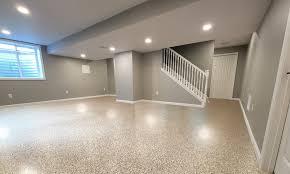When it comes to transforming your basement into a clean, durable, and visually appealing space, epoxy flooring stands out as one of the best solutions. Whether you use your basement for storage, as a home gym, or as an entertainment area, epoxy flooring offers strength, longevity, and a sleek finish that other materials simply can’t match.
In this guide, we’ll cover everything you need to know about epoxy floors for basements—including their benefits, installation process, maintenance, and cost—so you can decide if it’s the right choice for your home.
What Is Epoxy Flooring?
Epoxy flooring is a seamless surface coating made from a combination of resin and hardener. When these components mix, they create a chemical bond that adheres firmly to concrete, forming a glossy, durable, and moisture-resistant surface.
Unlike regular paint, epoxy forms a thick protective layer that strengthens the underlying concrete. This makes it particularly ideal for basement floors, where moisture, cracks, and wear are common issues.
Why Choose Epoxy Flooring for Your Basement?
1. Moisture Resistance
Basements are prone to dampness, especially in humid or rainy climates. Traditional flooring materials like carpet, laminate, or wood can easily absorb moisture and lead to mold or mildew.
Epoxy, on the other hand, creates a non-porous, waterproof barrier that seals the floor against moisture infiltration. This helps keep your basement dry, hygienic, and odor-free.
2. Durability and Longevity
An epoxy-coated floor can withstand heavy use for decades without showing signs of wear. It resists chipping, cracking, or peeling—even under heavy furniture, gym equipment, or high foot traffic.
That’s why epoxy flooring is often found not just in homes, but also in industrial and commercial spaces like garages, warehouses, and workshops.
3. Aesthetic Appeal
Gone are the days when epoxy floors came only in dull gray. Modern epoxy coatings are available in a wide range of colors, patterns, and finishes—including metallic, matte, or high-gloss.
You can even add decorative flakes or create custom designs that reflect your personal style, turning a plain basement into a visually stunning space.
4. Easy to Clean and Maintain
Cleaning an epoxy floor is effortless. Since the surface is smooth and seamless, dirt, dust, or spills don’t penetrate it. A quick sweep and an occasional mop with mild soap are usually enough to keep it spotless.
Plus, the floor is resistant to stains, oil, and chemicals, making it a low-maintenance option for busy homeowners.
5. Enhances Lighting
Because of its reflective surface, epoxy can actually brighten up dark basements. This helps improve visibility and creates a more inviting atmosphere—perfect for converting your basement into a living area or workspace.
Types of Epoxy Flooring for Basements
There are several epoxy systems available, each with its unique benefits:
1. Solid Epoxy Coating
This is the most durable type of epoxy, often used in garages and commercial buildings. It creates a thick, protective layer that’s ideal for basements requiring heavy-duty performance.
2. Water-Based Epoxy
Easier to apply and less toxic, water-based epoxy is perfect for residential basements. It provides good adhesion, a smooth finish, and minimal odor during installation.
3. Metallic Epoxy
For homeowners who want a luxurious, high-end look, metallic epoxy offers a glossy, three-dimensional effect with shimmering tones. It’s both durable and decorative.
4. Epoxy Flake Flooring
This style incorporates colored flakes or chips within the coating, adding texture and visual appeal. It also provides extra slip resistance—ideal for basements that double as gyms or play areas.
How Is Epoxy Basement Flooring Installed?
While professional installation is recommended for the best results, here’s a step-by-step overview of the process:
1. Surface Preparation
The concrete floor must be cleaned thoroughly and any cracks or holes repaired. Sometimes, professionals will use a diamond grinder or acid etching to ensure proper adhesion.
2. Applying the Primer
A primer coat is applied first to penetrate the concrete and improve bonding. This layer also helps to minimize bubbles or imperfections in the final coat.
3. Mixing and Applying Epoxy
The resin and hardener are mixed precisely, then rolled onto the surface evenly using rollers. If you’re adding flakes or metallic pigments, they’re sprinkled or mixed in at this stage.
4. Curing Time
Epoxy needs time to cure and harden, usually 24–72 hours depending on temperature and humidity. Once cured, the floor becomes solid, glossy, and ready for use.
Cost of Epoxy Flooring for Basements
The average cost of epoxy flooring ranges from $3 to $12 per square foot, depending on the quality of materials, floor condition, and design complexity.
A standard 500-square-foot basement could cost anywhere between $1,500 and $6,000 for professional installation.
While that may sound like a big investment, epoxy’s long lifespan (10–20 years or more) and minimal maintenance costs make it an excellent long-term value.
Maintenance Tips for Epoxy Basement Floors
To keep your floor looking new for years, follow these simple maintenance tips:
-
Sweep or vacuum regularly to remove dust and debris.
-
Wipe spills immediately to avoid surface discoloration.
-
Use a gentle cleaner or pH-neutral soap for mopping.
-
Avoid dragging sharp or heavy objects across the floor.
-
Recoat every few years if you notice dullness or minor scratches.
Is Epoxy Flooring Right for Every Basement?
Epoxy is an excellent choice for most basements, but there are a few considerations.
If your basement has active water leaks or hydrostatic pressure, the moisture can push against the coating and cause bubbles or peeling. In such cases, fixing drainage or waterproofing issues first is crucial before applying epoxy.
Final Thoughts
A well-installed epoxy floor for your basement is more than just a cosmetic upgrade—it’s a long-term investment in durability, hygiene, and design.
With its waterproof nature, resistance to wear, and modern aesthetic options, epoxy can completely transform a dull, damp basement into a bright, usable, and stylish part of your home.
Whether you plan to create a home gym, entertainment zone, or extra living space, epoxy flooring delivers performance and beauty that lasts for decades.

